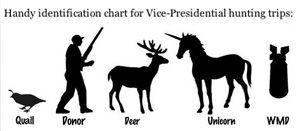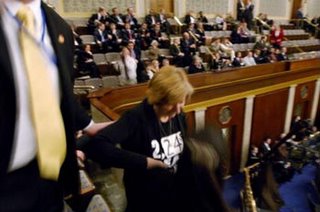Cheney's "Quailgate" Leaves Unanswered Questions

Retrieve Feb 15th, 2006 from: http://www.emagazine.com/view/?3096
By Jim Motavalli with Erin Coughlin
Many unanswered questions remain about Cheney's hunting adventure, which seems to have been conducted mere steps away from the comfort of luxury SUVs. Were these quail on the Armstrong Ranch wild or pen-raised captives, which are reportedly much easier to hit? Pen-raised birds, according to some veteran Texas quail hunters, are essentially "sitting ducks" that don't have enough native sense to fly to cover when flushed. They fly off in all directions instead of maintaining discipline and seeking group shelter.
The Armstrong Ranch denies that it uses pen-raised quail, but some observers have taken note of Cheney's light 28-gauge shotgun, which would more likely have been effective for domesticated fowl. It's considered a good choice for "small framed" and young shooters because it doesn't recoil much, but it's hardly the type of weapon the macho Cheney would seem to favor.
In any case, Cheney is no stranger to canned hunts. In December of 2003, he went (via Humvee) to a pheasant shooting party in Pennsylvania at the Rolling Rock Club. Gamekeepers there released some 500 pen-raised pheasants from nets, and Cheney's party, which included former Dallas Cowboys quarterback Roger Staubach and U.S. Senator John Cornyn (R-TX) as well as several influential Republican fundraisers, shot 417 of them. Cheney himself got at least 70. Apparently that wasn't enough slaughter, because after lunch the group went after pen-raised mallard ducks.
Cornyn had the audacity to claim later that the birds had a sporting chance, though he conceded that the hunt was so easy that at times it seemed "kind of like how Tyson's and Pilgrim's Pride and other people do it. I must tell you that people don't necessarily hunt the same way in Texas that they hunt in Ligonier, Pennsylvania, but it was enjoyable."
In 2004, Cheney got into trouble for going duck hunting with Supreme Court Justice Antonin Scalia in Louisiana while he had business before the court. It's not hard to see why the Vice President might favor guaranteed canned hunts because the shooting in Louisiana was poor. "The duck hunting was lousy," Scalia remarked. "Our host [owner of an oil services company] said that in 35 years of duck hunting on this lease, he had never seen so few ducks." But it ended well. "I did come back with a few ducks, which tasted swell," Scalia added.
Outdoor writer Ted Williams estimates there are approximately 3,000 canned hunting operators in the U.S., many of which offer the "sport" of releasing birds right in the path of waiting shotguns. This kind of hunting is banned (for at least one species) in California, New Jersey, New York, Oregon, Rhode Island, Wisconsin and, yes, Texas, where the practice nonetheless amounts to big business. In a typical operation, the animals are fed at specific times and locations, and learn to anticipate the sounds of approaching humans. So they're more likely to move toward the hunters than away from them.
"Cheney has a real history of questionable hunting behavior," says Wayne Pacelle, president of the Humane Society of the U.S. (HSUS). "He is apparently obsessed with hunting and is a regular patron of canned hunts. We don't like to see the Vice President of the U.S. providing pretty explicit endorsement of this practice, because canned hunting violates all the rhetoric that hunters use to justify themselves. Hunting is supposed to involve a fair chase with the animal having an opportunity to evade the hunter. But this eliminates the possibility of failure."
Some of the canned hunting ranches offer the chance to shoot endangered species, which typically consist of zoo-bred animals that outgrew their cuteness and were sold in exotic animal auctions. At the Renegade Ranch in Michigan, one price list charged $350 to shoot a Corsican ram, $450 for a Russian boar, $750 for a blackbuck antelope and $5,500 for a trophy elk. Among the zoos participating in such programs, according to a Humane Society of the U.S. investigation, are Buffalo Zoological Gardens, Busch Gardens in Florida, Six Flags Great Adventure in New Jersey, the Houston Zoo, the Kansas City Zoo and even the National Zoo in Washington, D.C.
The Connecticut-based Friends of Animals has filed a lawsuit aimed at keeping three species of endangered antelope out of the canned-hunt trade. "This is a lazy person's idea of hunting," says Priscilla Feral, the group's president. "They drive right up to the animal."
The first George Bush celebrated his 1988 election victory with a canned quail hunt at the Lazy F Ranch near Beeville, Texas. And he apparently didn't "get it" any more than Cheney does. "These aren't animals, these are wild quail," he reportedly responded to criticism. President Clinton also hunted in shooting preserves during his Presidency. In 1993, he shot a captive-bred mallard at a Maryland preserve owned by a lobbyist who ran DUCPAC, a pro-hunting political action committee that gave out $35,000 in campaign contributions.
In addition to asking Cheney to explain the nearly 24-hour gap between the hunting accident and public notification, reporters are wondering how the Vice President could have broken a cardinal hunting rule. According to Time, "An eyewitness account reported by the Associated Press suggests that Cheney may have, in the heat of the moment, violated the number one rule of hunting by failing to keep track of his hunting buddies at all times….For the shooter, hunting safety dictates that focusing on the target should never be more important than keeping in mind what's behind it."
Vice President Cheney, adept at shifting the blame for Iraq and disastrous energy policies, also chose to blame the victim in the hunting incident. Whittington, a 78-year-old lawyer and Republican Party functionary, apparently failed to announce himself when he came up behind "Deadeye Dick."
Columnist Molly Ivins summed up this Bush administration's tendency to avoid any and all responsibility for the messes it creates: "I was offended by the never-our-fault White House spin team," she wrote. "Cheney adviser Mary Matalin said of her boss, 'He was not careless or incautious (and did not) violate any of the (rules). He didn't do anything he wasn't supposed to do.' Of course he did, Ms. Matalin, he shot Harry Whittington.
"Which brings us to one of the many paradoxes of the Bush administration, which claims to be creating 'the responsibility society.' It's hard to think of a crowd less likely to take responsibility for anything they have done or not done than this bunch. They're certainly good at preaching responsibility to others—and blaming other people for everything that goes wrong on their watch," wrote Ivins.


